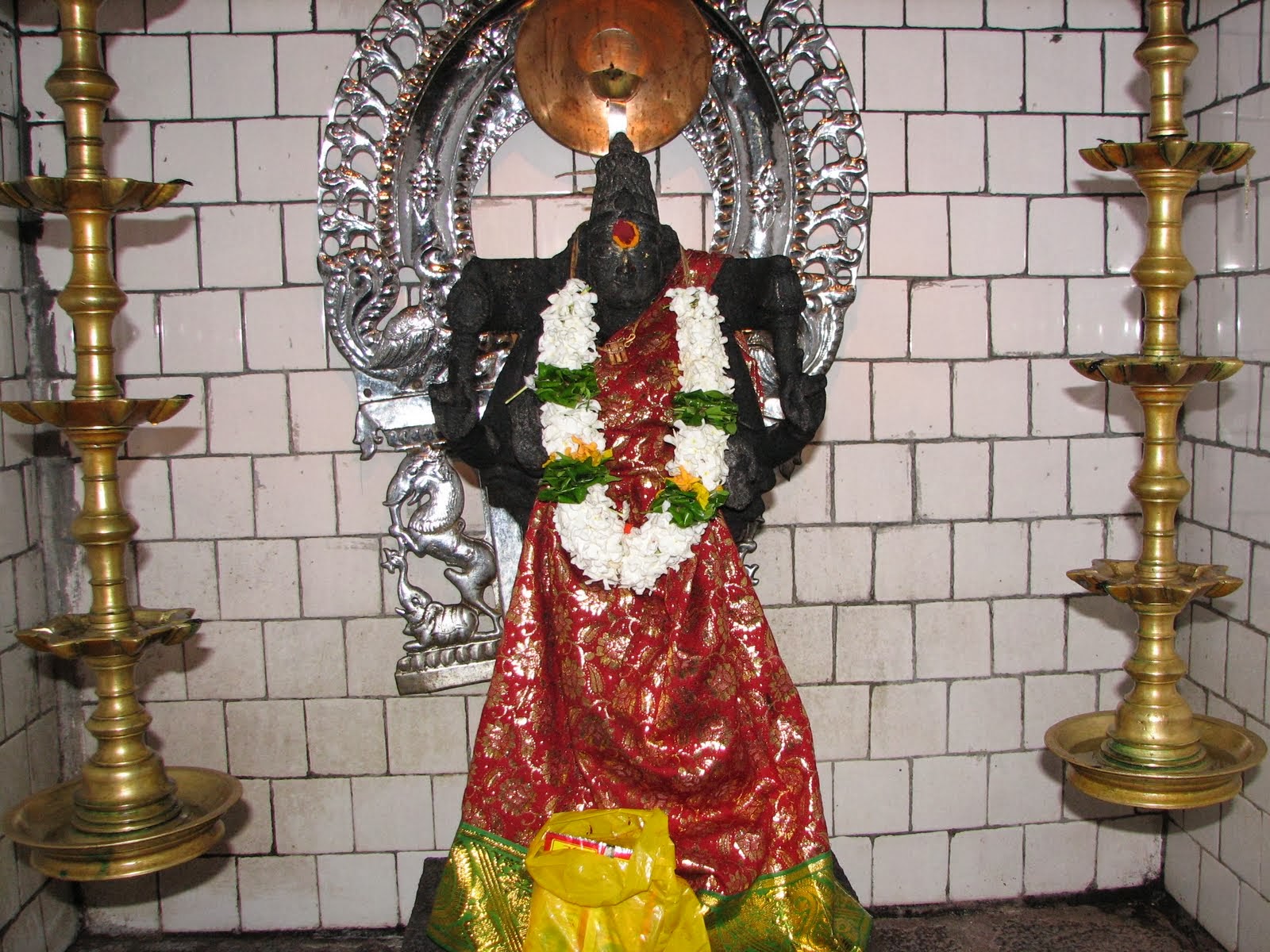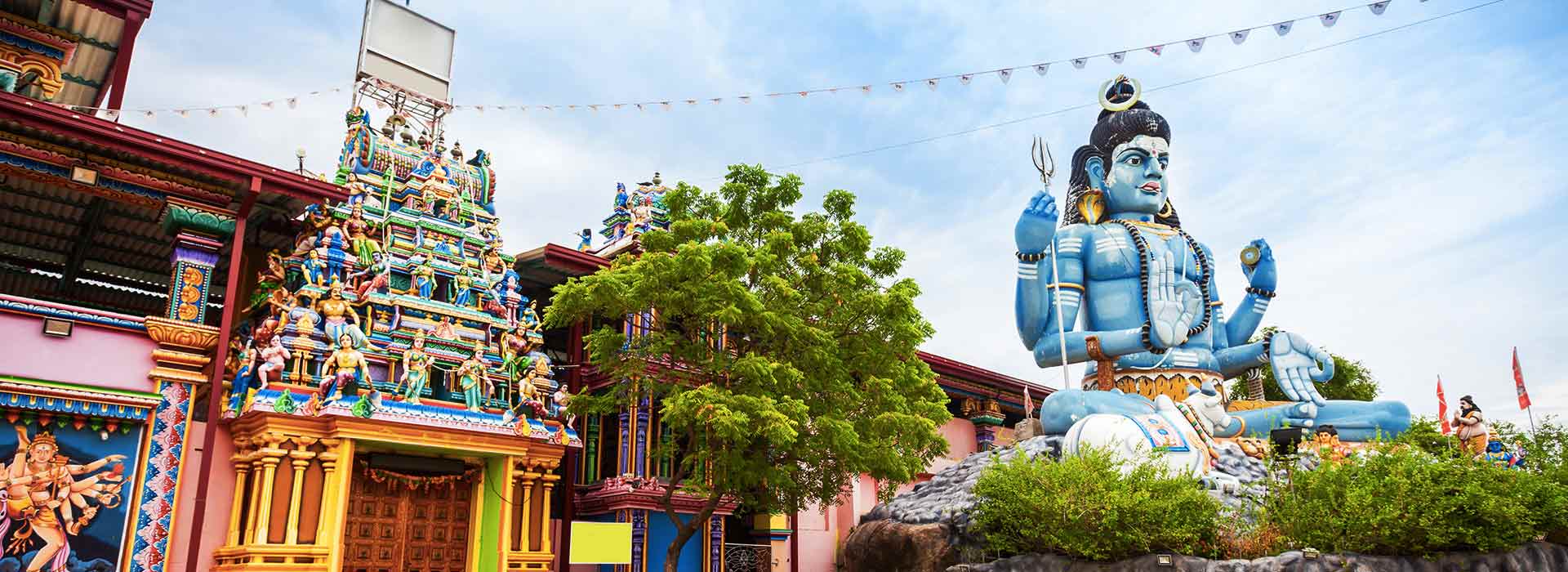
Koneshwaram Temple in Srilanka is dedicated to Lord Shiva as Konanatha Swami and his consort Parvathi Devi as Mathumai Ammal. The temple is located on Swami Rock (a promontory) in Trincomalee, a port city in the Eastern province of Srilanka. Also called as Thirukonamalai Konesar Temple – the temple of the thousand pillars or Dakshina-Then Kailasam, it is the most prominent and one of the Pancha-Ishwaram temples of Srilanka.
Being a victim of Portuguese attacks, the temple was destroyed around 1624 CE and rebuilt a few years later during the British rule. The once famous 1000 pillared mandapam of the temple is gone forever. It is said that Lord Rama established a second Shivalinga here.
A unique fact about the temple is that it lies on the same longitude as that of Mt. Kailash.
References to the Koneshwaram Temple
Volume three of the Mahabharata speaks the following about Koneshwaram:
“Listen as I now recount the isle of Tamraparni below Pandya-desa and Kanyakumari, gemmed upon the ocean. The gods underwent austerities there, in a desire to attain greatness. In that region also is the lake of Gokarna. Then one should go to Gokarna, renowned in the three worlds.
O Indra among kings! It is in the middle of the ocean and is worshipped by all the worlds. Brahma, the Devas, the rishis, the ascetics, the bhutas (spirits or ghosts), the yakshas, the pishachas, the kinnaras, the great nagas, the siddhas, the charanas, the gandharvas, humans, the pannagas, rivers, ocean and mountains worship Uma’s consort there.”
In the Shaivaite Tevaram records, Sambandar says the following during the reign of Mahendravarman I:
“Konamalai is the abode of our Lord Shiva, where despite the wrong beliefs and evil efforts of the Jains and those that follow Theravada, the rearing waters of the sea scatter on the shore sandalwood, precious stones and pearls – all of value high, for where he settled.”
Many more testimonials about the greatness of Koneshwaram Temple abound globally.
History of Koneshwaram Temple
Based on the inscriptions from the ruins of the old Koneshwaram temple structure, it is estimated to have been built before 400 BCE. But there is no clarity on the exact time-period.
Kaviraja Varothiyan’s Tamil poem inscribed on the 17th century stone inscription of the temple points to the construction of the Koneshwaram temple in 1580 BCE. Archaeologists suggests that the temple was originally a cave temple with multi-layered brick structure constructed by Tamils during the Sangam era.
Between 1580 BCE and 1250 CE, the Kings of the great Chola dynasty had renovated the temple and the Kantalai tank. King Kankan Kulakkottan Cholan, the descendant of King Manu Needhi Cholan of Thiruvarur had specifically restored the temple to its glory and lavished it with wealth, lands, etc. He created a settlement around the temple for the upkeep of the temple. Two more temples on the promontory dedicated to Lord Vishnu and Devi were also renovated.
The grandeur of the temple increased during the times of the Cholas and Pandyas. Kings and eminent personalities from all over the world had visited Koneshwaram and written records of its grandness, even calling it grander than the Rameshwaram temple.
The Yalpana Vaipava Malai, an 18th century book written by the Tamil poet Mayil Vaakanaar connects the restoration of Koneshwaram temple to a personality named Vijaya and 700 of his followers. They renovated the Pancha Ishwaram temples of Srilanka and then settled on the island mixing with the tribes and forming matrimonial relations with the Pandyan queens.
Later, Sundara Pandyan of the Pandyan dynasty had renovated the gopurams by gold-plating the roofs and installing gold-gilded kalashas atop them.
Post the Portuguese rule of Koneshwaram, the Dutch and British ruled. No worship was allowed at the temple or the promontory until the British came in. After the British gave permission to resume worship at the temple, the flow of devotees has steadily risen until day.
Deities and artefacts are recovered and reinstated
In 1950 CE, the Urban Council of Trincomalee recovered many artefacts that belonged to the original temple structure while digging a well. These artefacts were spread 500 yards away from the Koneshwaram temple. These included gold, bronze, copper alloy deities and figures said to be from the 10th century.
A seated figure of Somaskanda, Chandrasekhara, Parvathi Devi, Goddess Mathumai Ambal and Ganesha were amongst those found. They were taken in procession around the region before being installed at the Koneshwaram temple.
It is said that the swayambhu lingam consecrated here was one of the 69 Shivalingas found on Mt. Kailash. King Ravana had brought this here. This swayambhu Shivalinga was found from the ocean floor in 1956 by Mike Wilson, a photographer and Arthur C. Clarke, an author while scuba-diving.
Many other relics, deities, artefacts, etc. belonging to the temple too were discovered by them. They were thrown into the sea by priests and devotees of the temple when the Portuguese came attacking and destroying the temple in April 1622 CE. Some others were pushed into the sea by the Portuguese themselves.
The prophesy of Koneshwaram Temple
Amongst the temple ruins of Koneshwaram temple were many artefacts such as temple documents, Portuguese maps of the temple, etc. One particular document turned out to be the translation of a stone inscription found in the old temple premises. This inscription in old Tamil had a Pandyan insignia of the twin-fish. The Pandyan dynasty existed between 6 BCE and 16 CE.
It was a prophesy which when translated read “O King! The franks shall later break down the holy edifice built by Kulakoddan in ancient times; and no future kings of this island will rebuild it! Following the successive reigns of the cat eyed, the red eyed and the smoke eyed nations it will voluntarily revert to the Tamils.”
Deities of Koneshwaram Temple
The main Deity of the temple is Konanatha Swami (swayambhu Shivalinga) accompanied by his consort Mathumai Ammal. Deities of Narthana Vinayagar (dancing Ganesha), Thadshanamoorthi, Lingotpavar, Brahma and Thurkai have been embedded on the walls of the sanctum.
There are shrines for Parvathi Devi, Ganesha, Karthikeya with his consorts Valli and Devayani. A shrine with a small bronze Shivalinga can be seen around. There is a mini shrine for Sandeshwarar.
In the Vasantha mandapam sits the small metal deity of Eluntharuli. Vairavar (Bhairava) is the guardian deity of the temple.
In the long shrine to the left of the main entrance are the four deities of the Nayanars i.e. Sundarar, Sampandar, Manickavasakar and Navukarasar. The authorities plan to install the deities of the other Nayanars too.
The Pathrakali temple on the way to the Koneshwaram temple was once part of the main temple complex. You can have darshan here ideally while coming back.

Architecture of Koneshwaram Temple
The old destroyed temple was known as Aayiram Kaal Mandapam Kovil i.e. temple of thousand pillar mandapam. The Europeans called it as the Pagoda of Trincomalee. Old structure or new structure; both sport the classical Dravidian architecture.
But the older temple was mesmerizing to behold, ravished with the finest elements of Dravidian architecture at its zenith.
The moolasthanam of the temple is divided into two unlike other temples. One is the sanctum of the swayambhu lingam of Konanatha Swami. To the left of Lord Konanatha Swami is the shrine of Mathumai Ammal, the consort of the Lord.
The inner walls and the roofs of the temple are beautifully sculpted and painted colourfully. The pillar seen on the right side after entering the temple has a large image depicting all the shrines in the temple complex and the order of worshipping them. As you enter the temple, seated on the left wall is a beautifully painted image of the original temple which was destroyed more than 400 years ago.
The inner temple walls have paintings from the various lilas of Lord Shiva and scenes from the history of the temple with one-line descriptions in English, Tamil and Sinhalese. The older stone figures around the temple have been carved with the finest precision while the newer ones are simply basic.
There is a small courtyard outside the temple which is narrow towards the back and faces the ocean. It is covered by a high-pillared wall.
Festivals of Koneshwaram Temple
The main festivals celebrated here are Shivaratri, Navaratri and Ther festival. The Ther festival is the chariot festival which lasts for 22 days in the month of April every year.
An annual three-day procession happens after the Shivaratri day. This has been the custom since the discovery of the bronze deities in 1950 CE.
On the first day, the deities of Sri Konanatha Swami, Mathumai Ammal, Ganesha and Karthikeya with his consorts are taken out on a procession through the Trincomalee town on chariots. On the second day, the procession goes to Sri Pathirakalai Ambal temple where the deities remain for the evening. On the third day, the procession goes back to the Koneshwaram temple.
The annual Thirukoneshwaram Ther Thiruvilah festival begins with the hoisting of the flag of Nandi. The Deities of Lord Konanatha Swami and his consort Mathumai Ammal are taken out on an ornate chariot. Their children Ganesha and Karthikeya with his consorts go ahead in separate chariots.
The chariot procession was reintroduced in 2003 centuries after the destruction of the temple in 1624. The Theertham Thiruvilah i.e. holy bath of the deities happen during the Ther festival in the centuries-old Papanasachunai (Papanasanam Theertham) on Swami rock. After this, the devotees are sprinkled with the water from the Theertham.
The Theppath Thiruvilah boat festival and the Poongavanam festival too happens during the Ther festival.
Temple Timings of Koneshwaram Temple
The temple is open for darshan at the following times –
Morning: 6 AM to 1.30 PM
Evening: 4.30 PM to 7 PM
Darshan closes for half-an-hour from 11 AM to 11.30 AM for pujas during the morning period.
How to Reach Koneshwaram Temple
If you are booked on the Srilanka Ramayana Yatra conducted by Tirtha Yatra, your darshan along with the most unique experience of Koneshwaram temple is guaranteed.
You have to reach Trincomalee to be able to visit the temple. You can pick one of the modes of transportation from Colombo to Trincomalee –
By Road: The National Transport Commission operates buses from Colombo Bastian Mawatha Bus terminal to Trincomalee every hour. Superline travels too operates one bus a day. Taxi services are available too and faster though costlier than buses.
By Rail: Srilankan railways operates one train a day from the Fort station in Colombo to the Trincomalee station.
By Air: The nearest airport is the Batticalao International Airport 136 kms away. You can fly in here and use the rail or road route to reach Trincomalee. Taxi would be the fastest means to reach.
0










Leave a Reply